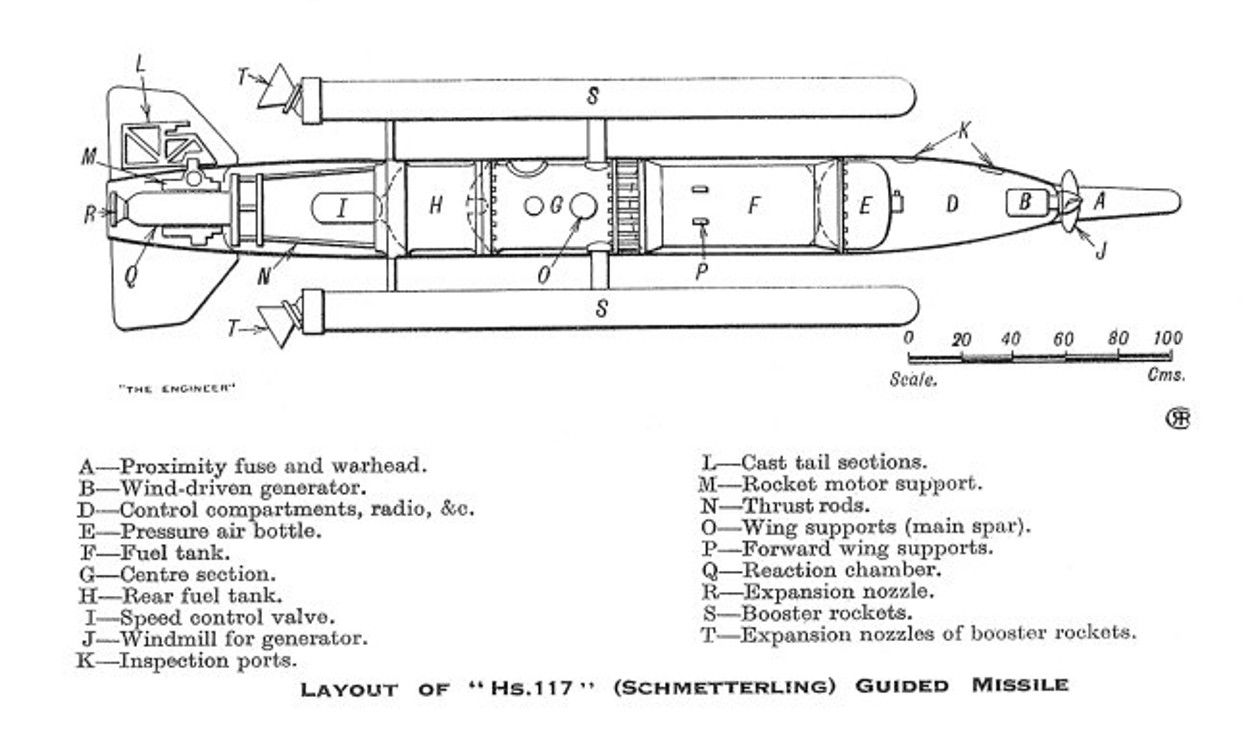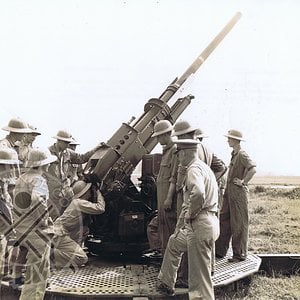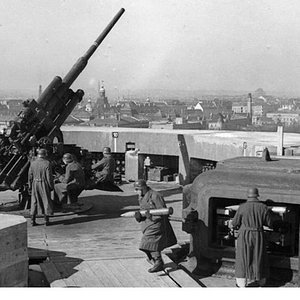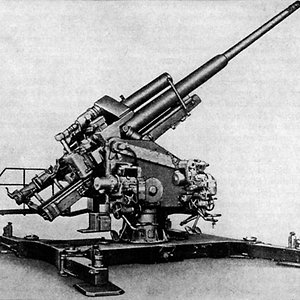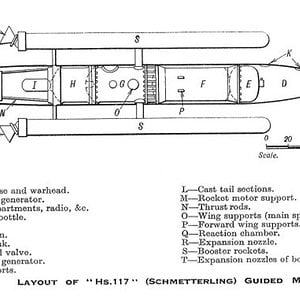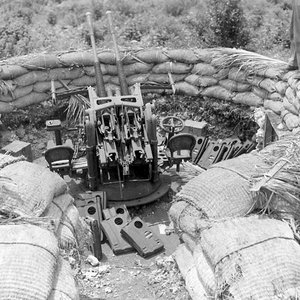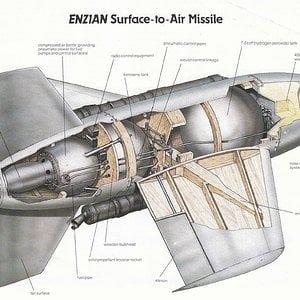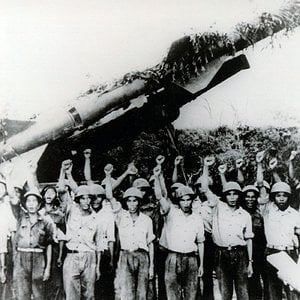Navigation
Install the app
How to install the app on iOS
Follow along with the video below to see how to install our site as a web app on your home screen.
Note: This feature may not be available in some browsers.
More options
You are using an out of date browser. It may not display this or other websites correctly.
You should upgrade or use an alternative browser.
You should upgrade or use an alternative browser.
BMW were given the initial contract to supply an engine for Schmetterling, and chose the fuel/oxidant mixture employing nitric acid, on which they had been working for some time. This they considered gave superior results to the Walterwerke peroxide systems (although ironically, Dr. Schmidt of Walterwerke in Kiel proposed a nitric acid system in his HWK 109-729 alternative motor for Schmetterling).
Description.
BMW's 109-558 motor used a combination of "Salbei" (the Nitric Acid oxidant) and "Tonka 500"* as the fuel. BMW dedicated a large amount of development work to different combinations of amines, xylidines and anilines which comprised their Tonka fuel series. So far, research has shown that the Tonka fuel was used in advance of the "Visol" fuel which BMW were also working on, but as BMW worked on so many fuel combinations and formulae, the situation is difficult to clarify, and the author is happy to concede to correspondents who wish to contradict this view.
Compressed air is used to force propellants into the combustion chamber in the correct ratio, and as these are hypergolic, and undergo spontaneous combustion when brought into intimate contact, a consistency in the ratios is important. To control the propellant flow, BMW designed a sophisticated tank system, driven by compressed air.
-: Top of Page :- -: Back to Hs.117 Page :-
Operation.
The tank system consists of three tanks. The forward tank, made of welded sheet steel contains the air propellant under pressure. Six and three quarter pounds of air, charged at 220 atmospheres is held here. At the rear of the tank is a connection containing a diaphragm, punctured by by an electrically fired cartridge.
On starting the motor, air was led from the air tank, via a reducing valve to 40 atmospheres onto the head of each propellant tank. At the upstream end of the tanks a metal diaphragm holds back the air, but can be ruptured at 40 atmospheres. The diaphragms are to protect the propellants from the air during storage and handling, and to make sure that no fluids flow until pressure is equal in both tanks.
The second tank containing 126lb of the oxidant is an aluminium casting, bored to take a closely fitting piston without rings, with a clearance of 0.012 inches. Filled, the liquid forces the piston against the head of the cylinder. On admission of the compressed air, the cylinder is forced down, pressing the liquid out of the tank. The design of the piston is to prevent air being introduced into the lines when the missile is manouvering.
The rearmost tank is similar to the nitric acid tank, but contains 30lb of the liquid fuel. As described, BMW tried a number of fuels, but Tonka 500 was the one most frequently used. Between the two tanks a distance piece carries a casting for the wings and the device for blowing off the solid rocket boosts. Pipes carry the propellants to the combustion chamber and are fitted with filling orifices to enable them to be filled before the Schmetterling was fired. This was to promote the most rapid starting of the motor.
The combustion chamber consists of a steel, convergent-divergent venturi, with an aluminium cooling jacket around the throat, and an outer casting of aluminium. The combustion chamber head is a cast aluminium cover plate with a steel valve chest.
The combustion chamber has two sets of injection holes to lead fuel to the burner. One set is permanently open, the second set can be moved from closed to open under the control of the Mach Controller. There are twice as many oxidant jets as fuel jets, to maintain the 2:1 ratio for correct combustion.
The Tonka 500 fuel reaches the jets through a light alloy pipe from the fuel tank. Passing through holes in the fuel valve which are permanently open to a single, central jet discharging axially into the burner. Oxidant is delivered to the outer casing of the combustion chamber at the entrance to which is a bursting disc. The acid then flows through the cooling jacket surrounding the combustion chamber, forward to the combustion head. Fluid is directed into the burner through two fixed, diametrically opposite holes, impinging the central fuel jet at an angle of 45o.
The variable flow system for altering the speed of the missile in flight consists of a ring of 12 fuel jets and 24 oxidant jets terminating in drilled holes at the face plate of the combustion chamber head. The valves consist of two drilled, shaped plates which sit covering the fuel and oxidant jet holes, held by spring pressure, geared to a common spindle. The valve plates can be rotated by a small electric motor, governed by the Mach number regulator. This movement affects pairs of fuel jets (and corrspondingly, four oxidant jets), which are opened or closed, as required.
The BMW-Henschel Mach controller consists of a barograph needle which opens or closes an electrical circuit connected to two magnetic relays. The barograph needle is balanced centrally between two pressure capsules, one of which is connected to a static pressure pitot, the other of which is deformed as a function of total dynamic pressure. If the ideal speed of Mach 0.77 is exceeded (for example) the deflected needle causes a metal strip to make a contact on one side. The contact closes a relay which starts a geared electric motor taking a 24 volt supply from the distribution board in the nose of the missile, turning in one direction. The motor drives the valves in the combustion chamber head so as to close fuel and oxidant jets, reducing the motor's thrust.
If the speed of the missile falls, the pressure system moves the needle in the opposite direction, operates the other relay and causes the electric motor to rotate in the counter direction. Fuel and oxidant jets are uncovered, and the motor's thrust increased.
Discussion.
Specification
Weight Dry 166 lb
Impulse at Mean Thrust 22,100 lb sec
Duration (Mean Thrust) 48 sec
Description.
BMW's 109-558 motor used a combination of "Salbei" (the Nitric Acid oxidant) and "Tonka 500"* as the fuel. BMW dedicated a large amount of development work to different combinations of amines, xylidines and anilines which comprised their Tonka fuel series. So far, research has shown that the Tonka fuel was used in advance of the "Visol" fuel which BMW were also working on, but as BMW worked on so many fuel combinations and formulae, the situation is difficult to clarify, and the author is happy to concede to correspondents who wish to contradict this view.
Compressed air is used to force propellants into the combustion chamber in the correct ratio, and as these are hypergolic, and undergo spontaneous combustion when brought into intimate contact, a consistency in the ratios is important. To control the propellant flow, BMW designed a sophisticated tank system, driven by compressed air.
-: Top of Page :- -: Back to Hs.117 Page :-
Operation.
The tank system consists of three tanks. The forward tank, made of welded sheet steel contains the air propellant under pressure. Six and three quarter pounds of air, charged at 220 atmospheres is held here. At the rear of the tank is a connection containing a diaphragm, punctured by by an electrically fired cartridge.
On starting the motor, air was led from the air tank, via a reducing valve to 40 atmospheres onto the head of each propellant tank. At the upstream end of the tanks a metal diaphragm holds back the air, but can be ruptured at 40 atmospheres. The diaphragms are to protect the propellants from the air during storage and handling, and to make sure that no fluids flow until pressure is equal in both tanks.
The second tank containing 126lb of the oxidant is an aluminium casting, bored to take a closely fitting piston without rings, with a clearance of 0.012 inches. Filled, the liquid forces the piston against the head of the cylinder. On admission of the compressed air, the cylinder is forced down, pressing the liquid out of the tank. The design of the piston is to prevent air being introduced into the lines when the missile is manouvering.
The rearmost tank is similar to the nitric acid tank, but contains 30lb of the liquid fuel. As described, BMW tried a number of fuels, but Tonka 500 was the one most frequently used. Between the two tanks a distance piece carries a casting for the wings and the device for blowing off the solid rocket boosts. Pipes carry the propellants to the combustion chamber and are fitted with filling orifices to enable them to be filled before the Schmetterling was fired. This was to promote the most rapid starting of the motor.
The combustion chamber consists of a steel, convergent-divergent venturi, with an aluminium cooling jacket around the throat, and an outer casting of aluminium. The combustion chamber head is a cast aluminium cover plate with a steel valve chest.
The combustion chamber has two sets of injection holes to lead fuel to the burner. One set is permanently open, the second set can be moved from closed to open under the control of the Mach Controller. There are twice as many oxidant jets as fuel jets, to maintain the 2:1 ratio for correct combustion.
The Tonka 500 fuel reaches the jets through a light alloy pipe from the fuel tank. Passing through holes in the fuel valve which are permanently open to a single, central jet discharging axially into the burner. Oxidant is delivered to the outer casing of the combustion chamber at the entrance to which is a bursting disc. The acid then flows through the cooling jacket surrounding the combustion chamber, forward to the combustion head. Fluid is directed into the burner through two fixed, diametrically opposite holes, impinging the central fuel jet at an angle of 45o.
The variable flow system for altering the speed of the missile in flight consists of a ring of 12 fuel jets and 24 oxidant jets terminating in drilled holes at the face plate of the combustion chamber head. The valves consist of two drilled, shaped plates which sit covering the fuel and oxidant jet holes, held by spring pressure, geared to a common spindle. The valve plates can be rotated by a small electric motor, governed by the Mach number regulator. This movement affects pairs of fuel jets (and corrspondingly, four oxidant jets), which are opened or closed, as required.
The BMW-Henschel Mach controller consists of a barograph needle which opens or closes an electrical circuit connected to two magnetic relays. The barograph needle is balanced centrally between two pressure capsules, one of which is connected to a static pressure pitot, the other of which is deformed as a function of total dynamic pressure. If the ideal speed of Mach 0.77 is exceeded (for example) the deflected needle causes a metal strip to make a contact on one side. The contact closes a relay which starts a geared electric motor taking a 24 volt supply from the distribution board in the nose of the missile, turning in one direction. The motor drives the valves in the combustion chamber head so as to close fuel and oxidant jets, reducing the motor's thrust.
If the speed of the missile falls, the pressure system moves the needle in the opposite direction, operates the other relay and causes the electric motor to rotate in the counter direction. Fuel and oxidant jets are uncovered, and the motor's thrust increased.
Discussion.
Specification
Weight Dry 166 lb
Impulse at Mean Thrust 22,100 lb sec
Duration (Mean Thrust) 48 sec

